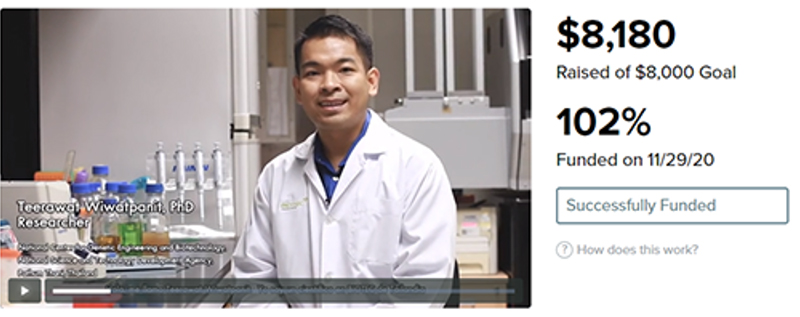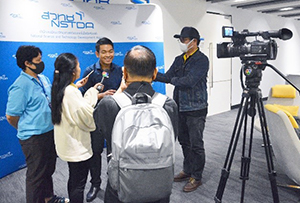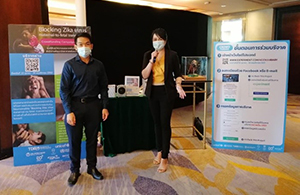Dr Teerawat Wiwatpanit has successfully met his crowdfunding target of US$ 8000 through a research crowdfunding challenge supported by TDR Global. The proceeds will be used to fund his research on blocking in vitro mother–to–child transmission of the Zika virus.
Many infectious diseases researchers in low- and middle-income countries (LMIC) face difficulties when applying for research grants. Crowdfunding may be able to address some of these challenges by allowing LMIC researchers to directly raise funds for their research. In partnership with Social Entrepreneurship to Spur Health (SESH), TDR Global launched a challenge contest in 2019 to build capacity for crowdfunding for infectious diseases research in LMICs.
The purpose of the contest was to solicit research proposals from LMIC researchers and then provide training and mentorship for selected finalists. TDR Global members volunteered as Steering Committee members, judges, workshop training faculty, and mentors. Dr Wiwatpanit was one of five finalists selected through the contest and shares the story below on his successful crowdfunding campaign.

Our crowdfunding campaign “
This was the result of a year-long journey since being selected as one of the finalists of the TDR Global crowdfunding challenge contest. In addition to receiving training on public engagement on my research, I was also mentored by two TDR Global members, Dr Jackeline Alger and Dr Joe Tucker, who helped me develop both written and video pitches for the campaign by giving feedback and suggestions. Jackeline also helped translate the video pitch into Spanish so that we could expand our base to include a wider audience. I also joined a monthly meeting of the other crowdfunding finalists organized by TDR.
Once the campaign was polished, we worked with the Public Relations (PR) department at our institution, the National Center for Genetic Engineering and Biotechnology, Thailand, to get it out to the public. We held a press conference as well as live interviews with local news stations. On the day of these interviews, the traffic to the campaign website increased significantly as well as the amount of donations. |  |
The PR team and I also set up a booth at a science conference and a local farmers market to advertise the crowdfunding campaign and collected cash donations. We were fortunate that the pandemic situation in Thailand was effectively controlled for the most part, and we were able to advertise our crowdfunding campaign in person at academic and social events – with all safety measures implemented, of course.
 | At the end of each event, the PR team deposited the cash donation to the campaign website. We asked each donor for information such as name and phone number for the record as Experiment.com’s model for crowdfunding is all-or-none, and in case the goal was not met, we would return all the donations to each backer. |
As for social media outreach strategy, I was quite active on social media platforms like Facebook, Twitter and TikTok to advertise this crowdfunding campaign. I contacted a few social media influencers who agreed to share my posts on their platforms, which helped tremendously to bring in traffic and donations to the campaign from both local and international backers. My contacts from college, graduate school and social circles from when I used to live in the United States also helped share the campaign and bring in more traffic.
In general, we had more local backers donating to the campaign than international ones. However, although we had fewer numbers of international backers (mainly from the United States), these backers donated a higher amount of funds to our campaign compared to local backers. One interesting thing that I observed was that local backers were more reluctant to use their credit cards to donate through the campaign website and preferred to give cash instead.
Crowdfunding for science was such a new territory for us to explore, and we have learned a lot along the way from the capacity building workshop with TDR in Geneva back in 2019. This experience has highlighted the importance of science communication – how researchers can bring science to the public in a way that feels relatable. We are very grateful for all the support from everyone – family, friends, colleagues, former professors, supervisors, to name a few –on this crowdfunding campaign. We are very excited to get our project on blocking Zika virus mother–to–child transmission up and running.
For more information, please contact Dr Beatrice Halpaap.

